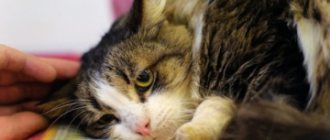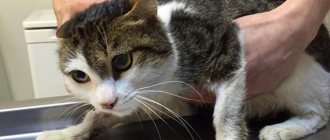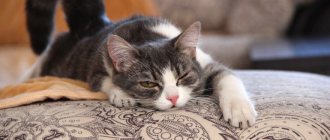How does a cat's behavior change before giving birth? The answer to this question interests almost all new owners. The difficulty is that changes in behavior are very individual... some “guerrilla cats” do not show signs of pregnancy until they “round up”. Let's see what features you can notice in the behavior and physiology of a pregnant cat.
Cat pregnancy, important nuances
Pregnancy in cats follows a specific cycle. According to generally accepted rules, cats that have value should be bred. If everything is done according to the rules, the mating is planned and registered in the breed club.
As practice shows, most inexperienced owners are faced with the pregnancy of their wards after the fact, without keeping an eye on the ward during heat. The first sign of pregnancy can be considered the absence of estrus, which should occur according to the cycle. Typically the cycle is 3–4 weeks. So, if your cat has not started meowing and calling for a male cat, it is worth analyzing whether she could have had contact with a male during her last heat.
If your cat does not have a breed value, in order to avoid pregnancy and the hassle associated with it, it is recommended to sterilize your pet before the onset of sexual heat. With a responsible approach, you will maintain the health of your pet and will not encounter the problem of “adopting” kittens.
According to a strange “tradition,” it is believed that a cat bears and gives birth to kittens without complications. In fact, planning pregnancy and caring for the expectant mother is of enormous importance. Like all living beings, cats experience serious stress during pregnancy and require increased nutrition and care. After the birth of kittens, many cats, especially purebred cats, may suffer from complications.
Note! In early pregnancy, the owner has a choice - medical abortion or castration of the cat. In the late stages of pregnancy, the owner will have to come to terms with and take responsibility for the life and health of the kittens.
Regardless of whether you wanted to get kittens or not, as soon as you find out that your cat is pregnant, she needs to be seen by a veterinarian. Before planned mating, both parents are vaccinated and free of parasites. If preventive measures were not carried out before mating, some of them can be carried out in the first trimester. Some types of parasites can infect kittens in utero, leading to serious postpartum complications or death of the entire litter.
If you have decided that your pet will give birth to kittens, you must take the veterinarian's advice with full responsibility. The sooner you balance the diet of the expectant mother, the higher the chances of giving birth to full-term kittens and maintaining the health of the pet.
Important! If your cat is giving birth for the first time, you should prepare for possible complications. Some animals suffer from postpartum eclampsia, and with prolonged labor, there is a risk of inflammation of the uterus.
In early pregnancy, you need to enrich your cat's diet with calcium and other beneficial microelements. Calcium deficiency is likely to lead to postpartum eclampsia. Make sure that while your cat has a good appetite, she remains active and mobile. Obesity is guaranteed to lead to complications during childbirth.
The first symptoms of pregnancy in cats appear approximately three weeks after conception. In the third week, you may notice that your cat's nipples are enlarged and slightly swollen. The glands acquire a more saturated, pink hue. These changes occur against the background of the pet’s normal activity. In the fourth week, you may notice the first roundness of your belly. If a cat is carrying 2–4 kittens, this sign may appear at 5 weeks. During pregnancy, swelling of the nipples becomes obvious by the 4th week.
Seclusion due to illness
Sick and wounded animals instinctively hide, because they are unable to actively resist and withstand danger. Domestic cats who feel depressed do the same thing, shutting themselves off from the world and immersing themselves in their pain. They may avoid human company, but go to the hospital under a blanket, especially with chills and elevated body temperature.
Refusal of food, lethargy and reluctance to leave the shelter should alert the owner, since the stronger the disease, the weaker and more apathetic the animal becomes.
Preparing for childbirth
1–2 weeks before giving birth, the cat will begin what is called nesting. Usually, from the 7th week of pregnancy, the pet begins to look for a convenient shelf in the closet or other shelter that will become a nest. During this period, it is strictly forbidden to let the cat go for walks, as it may set up a nest outside the house.
Carefully monitor your pet's behavior and do not interfere unless absolutely necessary. If your cat decides to build a nest in your closet, it is wiser to empty the shelf for her than to move the nest to a more convenient place for you. It is necessary to pay attention to the preparation of the nest, if only because the cat can give birth on your bed, clothes or a stack of clean laundry.
Important! During the process of giving birth and feeding the offspring, the cat must be protected from stress as much as possible.
You can avoid negative consequences if you prepare the nest for birth yourself. Stores sell special boxes that are equipped with nests for women in labor. In fact, any sturdy cardboard box with high sides will do.
One wall is cut off, leaving a side that the cat can easily step over. When preparing the nest, it is better to stock up on an extra box, since during birth the cardboard may get wet and tear.
Important! Before making a nest out of a box, make sure that it is not fastened with sharp staples or glued with toxic substances.
Think in advance about how to close the top of the box so that the cat feels private and calm. A few days before giving birth and the onset of contractions, most cats become withdrawn and try to hide. For an expectant mother who will give birth for the first time, it is better to equip several nests at once. Before giving birth, the pet will choose a more optimal and safe (from her point of view) place.
Ambush hunting
Representatives of the cat family are not physiologically adapted to long, exhausting running and prolonged pursuit of prey, preferring hiding to catching up. Even the legendary cheetah sprinter sneaks as close to its prey as possible for a short, quick lunge.
Ambush hunting is common to all cats, and a domestic cat may suddenly imagine itself as a lion, jumping out from under the blanket after some moving object. Young active animals are especially prone to hunting games, loving to arrange a safari on a vacuum cleaner brush or the ankles of the mistress.
Sometimes cats can hide food in secret places, stocking up for a “rainy day,” so finding a dried piece of raw meat in their bed is a common occurrence for a cat owner.
Precursors of childbirth and the appearance of kittens
Normally, a cat's pregnancy lasts up to 65 days, but a delay of up to 71 days is considered non-critical. A few days before giving birth, the cat begins lactation - the production of colostrum, which looks like a clear or yellowish liquid.
1–2 days before giving birth, the cat’s base body temperature drops. If normally the temperature ranges from 37.7 to 39.1 degrees, then before birth it can drop to 37 degrees. This is normal and does not require intervention or treatment. With a decrease in body temperature, the cat may seem more apathetic, but as the experience of owners shows, most expectant mothers behave anxiously. The day before giving birth, the cat may refuse to eat and spend more time in the nest. A few hours before the onset of contractions, the expectant mother actively licks the genital area, which stimulates the onset of labor.
During the last week of pregnancy, especially after the cat's temperature has dropped, she should be kept in a separate room. Move the water bowl, feeder and tray to the nest so that the cat does not have to waste extra energy. During childbirth, a young mother has poor control over her body temperature, so it is important to monitor the humidity and temperature in the room. Kittens, immediately after birth, quickly become hypothermic , so if necessary, a heating pad is placed in the nest.
Advice: in order to protect the cat from stress and prevent rapid labor, it is advisable not to allow other pets, guests and younger family members into the room where the woman is in labor.
Contractions indicate the beginning of the labor process. The interval between the first contractions can last up to 30 minutes. As the experience of owners shows, the first contractions may go unnoticed. Immediately before labor pushing and is preceded by contractions less than 30 seconds apart.
By the time labor begins, you should have the following kit on hand:
- Several pairs of sterile surgical gloves.
- Pipette or syringe to remove mucus from the respiratory tract of kittens.
- Antiseptic, dental or cotton floss for tying the umbilical cord - useful if the cat loses too much strength in pushing.
- Sharp, sterile scissors.
- Clean, soft towels and moisture-wicking diapers.
- Cat milk replacer.
- Warmer.
- The number of the 24-hour veterinary service or the veterinarian who saw the cat during pregnancy.
The appearance of each kitten consists of four stages: contractions and pushing, birth of the kitten, expulsion of the placenta. It can take 10 to 12 hours from the start of contractions to the birth of the first kitten. During this period, the cervix will dilate and the kittens will move along the birth canal.
About a day before giving birth or just before contractions, a mucus plug will come out of the birth canal. This stage may go unnoticed if the cat went to the litter box to empty its bladder or bowels. During pregnancy, the mucus plug protects the cervix and protects the kittens from infections.
Important! If a cat gives birth for the first time, she can be in labor for up to 12 hours, or even for 24 hours. If the kittens are not born within 24 hours after the onset of labor, contact your veterinarian immediately.
The second stage is pushing. Pushing is the contractile activity of the uterus, which pushes the kittens into the birth canal. The more pressure is applied to the cervix, the more the cat will push. Normally, after the start of pushing, no more than 10 minutes pass until the amniotic sac with the kitten appears. Pushing for an hour indicates a protracted labor, and in this case it is better to consult a veterinarian.
Anti-stress nook
In case of danger, wild cats hide in a secluded place until the threat passes. The Pallas's cat escapes from enemies on high rocky ledges, and the lynx hides from hunting dogs high in the trees. At the same time, obeying a wise protective instinct, the animal tries to merge with the environment, squeeze in and spread out, becoming more invisible.
Domestic cats have their reasons:
- An alarmed cat will dive under the blanket, frightened by a sudden loud noise or an unfamiliar object.
- The animal will seek salvation in comfortable solitude from the intrusive caresses of guests.
- A stressful factor for your pet is a car ride, an exhibition or a visit to the veterinarian, so he will hide under the blanket.
- Hiding under a blanket is especially common for animals for which “personal space” is not provided in a noisy and crowded house.
The owner should not disturb the peace of the cat, hidden in the soft folds of the blanket, giving him the opportunity to calm down and restore psychological balance.
Behavior of a cat during childbirth and signs of complications
During the entire birth, the cat must remain in the nest. If the pet is worried and tries to leave, it must be picked up and calmed down. While struggling, the cat may feel the urge to defecate and go to the litter box. You shouldn’t interfere, but watch carefully what happens next.
With this development of events, especially during the first birth, immediately after defecation, a bladder containing the first kitten emerges from the cat’s birth canal. If this happens, there is no need to panic, just pick up the cat and carefully carry it to the nest. The anus and fur under the tail can be gently cleaned using wet wipes.
Postpartum eclampsia is a common, insidious and very dangerous complication for which you need to prepare in advance. In rare cases, a cat experiencing eclampsia may kill or even eat its own kittens. Such a sight is difficult to endure even for an experienced animal owner, but you will have to pull yourself together to save the life of your pet.
All kittens that are born after this must be picked up immediately, mucus removed from the respiratory tract independently and placed in a separate nest with a heating pad. To save the cat, she needs to start taking calcium supplements and carry out maintenance therapy!
Important! Call your veterinarian immediately if your cat tries to strangle your newborn kitten.
In very rare cases, a cat may kill her kittens if they are not viable. For example, with premature birth, premature kittens most often do not survive. However, for a healthy cat that does not suffer from a disorder of the central nervous system, it is more common to refuse to feed the offspring and completely ignore the kittens.
Sweet Dreams
Zoologists know that relatives of domestic cats are also prone to hiding, doing this for various reasons:
- Rest after the hunt. In nature, cats spend most of the day (from 18 to 20 hours) resting after hunting. During sleep, the animal is especially vulnerable, and therefore beds are arranged in hidden and hard-to-reach places. For cats in their natural environment, this could be a hole, an old hollow, a fork in large branches with dense foliage, or a rock crevice. The animal feels protected when the walls of the shelter touch the body. Most often, cats doze with their eyes closed, without turning off their sensitive “inner guard,” but for health and recuperation, complete relaxation and a deep sleep phase are necessary.
- Call of the Ancestors. It is this property that makes a domestic cat settle down to rest in a secluded place, which can be a hole-house, a basket with a woolen blanket or a blanket on the owner’s bed.
- Feeling of warmth and safety. The desire to surround themselves with a cozy “cocoon” is characteristic of cats of all ages, but small kittens are especially sensitive to touch, instinctively striving for something warm and soft, reminiscent of their mother’s fluffy side. Warmth, silence and twilight create a feeling of security, allowing the baby to sleep peacefully.
Causes of continuous meowing in adult animals
Adult cats also often begin to behave unbearably, mewing heart-rendingly all day long. There are several reasons for this behavior.
- The most common reason for a continuous “concert” is the onset of the cat’s estrus period . Cats who crave “love” behave in exactly the same way. The unsatisfied desire to continue their kind causes animals both psychological and physical discomfort. In addition, loud screams are necessary to notify the entire district of your desire and attract partners. If you are not ready to spay or neuter your pet, hormone therapy may provide relief. However, this method should be used only after consultation with a veterinarian.
- Some owners spoil their pets too much, indulging in all their whims. If you are the owner of a spoiled cat , then do not be surprised that she can meow continuously for hours while sitting next to the bowl. In this way, your pet is trying to convey to you the idea that he categorically does not like the food offered. There are animals so stubborn that they would rather die of hunger than agree to eat another type of meat or fish. The decision in this case is up to you. You can show strength of character and insist on your own, but if you have always indulged the animal’s whims before, then you should not disappoint him. Whatever you choose, be consistent in your parenting methods.
- In the wild, all cats are most active at night, so you shouldn’t be surprised when desire to play or socialize appears after sunset. After all, this is quite natural for him, but your behavior causes bewilderment and indignation of the animal. “How can you sleep when it’s the right time to communicate!” – the pet probably thinks and loudly expresses his indignation at your strange behavior. Be patient and do not react to his calling cries. Then, over time, the purr will understand everything and come to terms with such an incomprehensible, from his point of view, habit of sleeping at night.
- Always be attentive to your pet, because he cannot explain to you what health problems are tormenting him. If a cat meows for a long time and at the same time makes sounds that are atypical for itself, you should carefully examine the pet and make sure that touching different parts of the body does not cause painful sensations in it. If you notice any additional warning signs, take your pet to a veterinarian immediately.
Why does a cat need to hide?
The desire to hide in a dark place for a while is quite common among domestic cats. The hunter's instinct prompts them to take a position in a secluded corner so that they can calmly observe what is happening without being noticed. In other cases, especially small kittens, they want to be in a warm, cozy “nest”, where they are comfortable and safe. Fur babies grow and sleep a lot, so they need proper rest. Constantly playing TV and other noises do not provide the opportunity to have a good rest. Truly deep sleep is only possible in darkness and complete silence.
It should not be surprising that cats find secluded corners in completely different places.:
- closet,
- box,
- under the bed or sofa,
- washing machine drum,
- on the shelf,
- behind the battery,
- under the owner's blanket.
If the cat hides constantly, then you need to buy one for it in a special store or make a house yourself. Fluffy pets love such shelters. This is connected not only with psychology, but also with physiology. Cats often sleep curled up. When sleeping in a confined space, they can lean their back against the wall of the house, thus relaxing their muscles.
Health reasons
There are both easily solvable problems that cause continuous meowing, and dangerous painful conditions.
- The animal may feel unwell due to intoxication of the body with worms . Typically, such problems arise in kittens and, in addition to plaintive screams, are sometimes supplemented by trembling or bowel irregularities.
- If an animal continuously meows before, during and after bowel or bladder emptying, this behavior indicates diseases of the digestive or urinary systems .
- Constant screaming accompanied by slight shaking may indicate a spinal injury .
- When an animal rushes around the apartment, shakes its head, scratches its ear or muzzle, and at the same time its “meow!” is constantly heard, most likely the cat is worried about ear mites or an allergic reaction .
- Life-threatening situations are often accompanied by continuous meowing and a complete lack of appetite.
- Constant hoarse meowing may be a sign of a viral disease .
In all of the above cases, do not try to diagnose, much less treat, your pet yourself. Be sure to show your cat to a veterinarian, who will conduct a professional examination, identify the causes of unusual behavior and, if necessary, prescribe an effective course of treatment.











